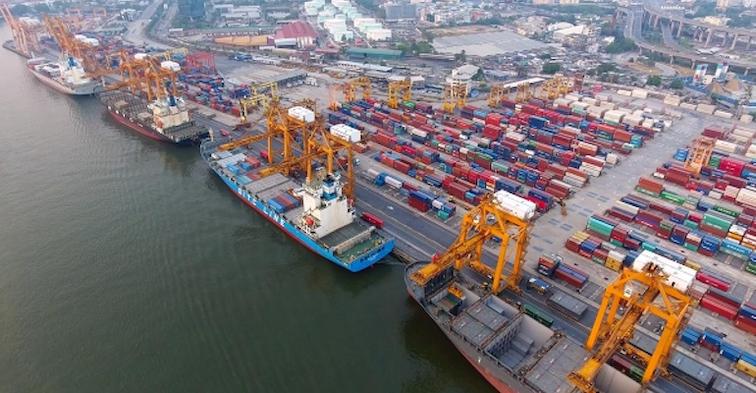Thailand - ท่าเรือกรุงเทพ (ฮ่องเต้)

Bangkok (Khlong Toei) Port has an area of 941 acres. The Port of Bangkok contains wharves, warehouses, admin offices, transit sheds, and open storage areas. Outside the Port of Bangkok’s Customs area is significant space for future development. The Port of Bangkok is easily accessible to Thailand‘s road and rail systems.
Additional Details of Bangkok Port (Khlong Toei)
- Container Capacity: 1.5 millions TEUs per year
- Draft / maximum vessel size: 8.5-11 metres
- Container cranes: Gantry cranes 14, mobile crane 10
- Open storage area: Open yard 2,208 TEUs, Empty yard 8,520 TEUs
Bangkok Port was constructed in 1938 with the purpose to enable large sea- going ships to transport goods directly to Bangkok. The work was interrupted during the second world war and completed after the war ended. In 1951, the government obtained a loan from the World Bank for dredging the sand bar. This involved deepening the river course to the Bangkok Port and purchasing loading / unloading equipment. Also in that year, under the Port Authority Act B.E. 2494 (1951) , The Port Authority of Thailand was established as an autonomous body. This was under the general supervision of the Ministry of Transport and Communications.
In 1961, the Royal Thai Government started its effort to construct a new deep-sea port at Laem Chabang, Chonburi to accommodate larger vessels which could not enter the Bangkok Port. However, due to the economic recession the project was suspended. The Sattahip port, formerly a Navy Port, was developed and operational for commercial purpose under PAT’s management in 1979.
Construction of Laem Chabang Port started in 1987. On 21 January 1991, the Port was officially opened at its multi – purpose terminal. The Sattahip Commercial Port was later returned to the Navy for military purpose.
One million TEUs
In 1997, the Laem Chabang Port hit the target of 1 million TEU and became Thailand’s major port. PAT, therefore, accelerates the construction of Phase 2, to cope with the rapidly increasing number of containers
Since 1951, the waterway transportation business has continuously advanced. In the past, the cargoes passed through the port were either conventional cargo or bulk cargo. The existing facilities were a West Quays for conventional and bulk ships. The modernization of container transportation played a significant role in Thailand during 1975 – 1977. The East Quays then were constructed for multipurpose berths and container vessels, and was operated since 1977.
Dealing with congestion
Since 1977 the loading and unloading of containers at the Bangkok Port had been gradually increased every year. This was until the Port began to be congested with containers due to the insufficient of handing equipment. Between 1987 – 1989 the severe congestion condition was taken place and the PAT had accelerated the development of the East Quays into the berths by installing 7 Gantry cranes in the first place. And had been added through the purchasing until now there are altogether 14 Gantry cranes in service.
The areas behind the port was improved so that the containers could be placed effectively and necessary handling equipment were provided including the introduction of the computers for use in the operation that enable the port to deal with the increasing capacity of containers up to 1.3 million T.E.U. The Government afterward required that container capacity at the Bangkok Port be limited at 1 million T.E.U. in order to mitigate the traffic problems and to encourage the ships to use more services at Laem Chabang Port.
Capacity at Bangkok Port (Khlong Toei)
Due to river port nature of the Bangkok Port, the dealing capacity for the large vessels was limited, followed by the economic growth that was necessary for the large port to be developed to cope with the increasing vessels and cargoes plus the severe congestion in 1987 and 1988 the acceleration was made by the Government for the Laem Chabang Port to be constructed with it was completed at the end of 1990 and was opened for service in January 1991. During the construction the private wharfs in the Chao Phraya River were used for temporary loading and unloading of container to mitigate the Bangkok Port congestion.
Throughout the past years, the service efficiency for Ports under the PAT’s responsibility had been developed. In addition, the modern administrative and management system and advanced technology were introduced, including the changing of the system in to the private business and for dealing with the related new business expansion in the future as well as to bring in the quality standard certifying system to apply for use to ensure the service users’ confidence. Today the PAT has been stepping forward to be the leading state enterprise playing significant role in developing the country’s export industry and trading economy. Its performance is in the top ten of all state enterprises that gained the highest income for the government and has assessed by the Government as the first class state enterprise successively for several years and has been recognized by local and foreign service users.
